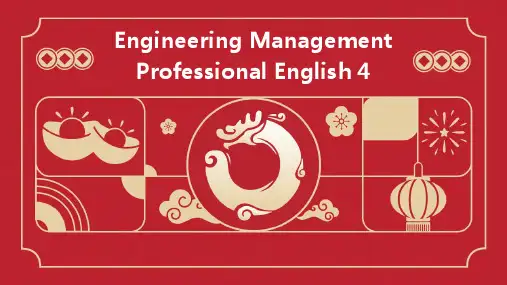工程管理专业英语(4)演示教学
- 格式:ppt
- 大小:213.50 KB
- 文档页数:41
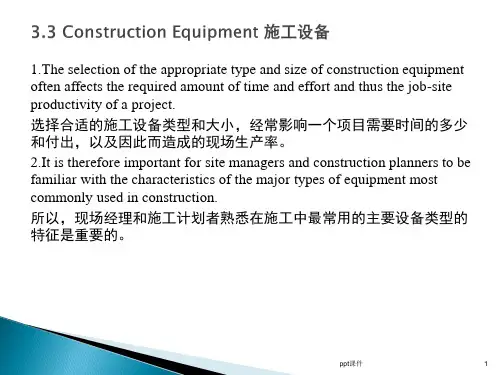
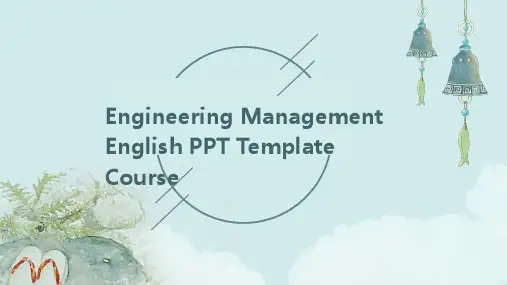
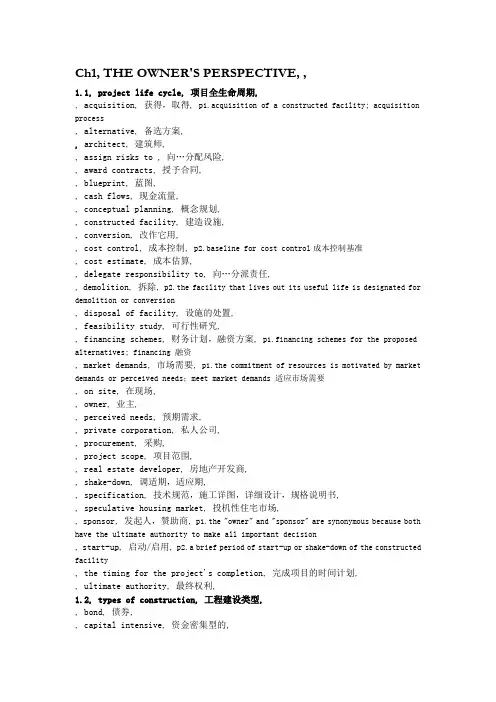
Ch1, THE OWNER'S PERSPECTIVE, ,1.1, project life cycle, 项目全生命周期,, acquisition, 获得,取得, p1.acquisition of a constructed facility; acquisition process, alternative, 备选方案,, architect, 建筑师,, assign risks to , 向…分配风险,, award contracts, 授予合同,, blueprint, 蓝图,, cash flows, 现金流量,, conceptual planning, 概念规划,, constructed facility, 建造设施,, conversion, 改作它用,, cost control, 成本控制, p2.baseline for cost control成本控制基准, cost estimate, 成本估算,, delegate responsibility to, 向…分派责任,, demolition, 拆除, p2.the facility that lives out its useful life is designated for demolition or conversion, disposal of facility, 设施的处置,, feasibility study, 可行性研究,, financing schemes, 财务计划,融资方案, p1.financing schemes for the proposed alternatives; financing 融资, market demands, 市场需要, p1.the commitment of resources is motivated by market demands or perceived needs;meet market demands 适应市场需要, on site, 在现场,, owner, 业主,, perceived needs, 预期需求,, private corporation, 私人公司,, procurement, 采购,, project scope, 项目范围,, real estate developer, 房地产开发商,, shake-down, 调适期,适应期,, specification, 技术规范,施工详图,详细设计,规格说明书,, speculative housing market, 投机性住宅市场,, sponsor, 发起人,赞助商, p1.the "owner" and "sponsor" are synonymous because both have the ultimate authority to make all important decision, start-up, 启动/启用, p2.a brief period of start-up or shake-down of the constructed facility, the timing for the project's completion, 完成项目的时间计划,, ultimate authority, 最终权利,1.2, types of construction, 工程建设类型,, bond, 债券,, capital intensive, 资金密集型的,, chemical processing plant, 化工厂,, coal-fired plant, 燃煤发电厂,, construction contract, 建设合同,施工合同,, drainage system, 排水系统,, functional requirement, 功能性要求,, general economic conditions, 总体经济条件,, high-rise apartment, 高层公寓式住宅,, infrastructure and heavy construction, 基础设施和重型项目建设,, institutional and commercial building, 公共及商用建筑,, labor intensive, 劳动密集型的,, large shopping-center, 大型购物中心,, light manufacturing plants, 轻工业制造厂,, litigation, 诉讼,, mechanization, 机械化,, monetary and fiscal policies of the government, 政府的货币和财政政策, , mass transit systems, 公共交通运输系统,, multi-family dwellings, 多户联排住宅,, nuclear power plant, 核电厂,, oil refinery, 炼油厂,, oligopoly, 寡头垄断,, pipeline, 管线,管道,, quality inspection, 质量检查,, recreational facilities, 娱乐设施,, residential housing construction, 住宅类房屋建设,, retail chain store, 连锁零售店,, risks and rewards, 风险与回报,, single-family houses, 单户独立式住宅,, skyscraper, 摩天大楼,, sewage treatment plant, 污水处理厂,, specialized industrial construction projects, 专业化工业建设项目,, steel mill, 轧钢厂,, subcontractor, 分包商,, tunnel, 隧道,, work force, 劳动力,, warehouse, 库房,1.3, professional services, 专业服务,, Architectural and Engineering(A/E) firms, 建筑工程设计公司,, at stake, 处于危险之中,在紧要关头,, brief, 项目建议书,任务纲要,, budgeting, 编制预算,, competitive bidding, 竞争性招标,, consortium, 联合体,, constructibility, 可建造性,, construction management, 施工管理,, contractual agreement, 合同协议,, CPA(certified public accountant), 注册会计师,, CPA(certified public accounting)firms, 注册会计师事务所,, design/construct firm, 设计/施工公司,, design/construct process, 设计/施工过程,, disclaimer of reponsibilities, 免责申明,, facilities management, 设施管理,, financial planning consultants, 财务计划顾问,财务规划咨询,, follow-up, 后续,, general contractor, 总承包商,, in-house capacities, 机构内部的人才能力,, in-house staff, 内部员工,, initial construction cost, 基本建设成本,初始建造成本,, investment decision, 投资决策,, lease, 租约,出租,, line manager, 一线管理者,, negotiation, 谈判,协商,, operation and maintenance, 运营与维护,, operation cost, 运行成本,, periodic field inspection, 定期现场检查,, planning and programming stages, 规划和设计阶段, p3.the owner retains direct control of work in the planning and programming stages, process plants, 加工厂,, professional consultant, 专业咨询顾问,, project management, 项目管理,, provisions, (法律)条款,, qualification, 资质,, real estate holdings, 物业,, rental properties, 租赁物业,, technical consultant, 技术咨询单位,, tenant, 租户,承租人,, turnkey approach, 交钥匙方式,, value engineering, 价值工程,Ch8, CONSTRUCTION PLANNING, ,8.1, a natural hierarchy, 关系自然的层次结构,, borrowing expense, 借款费用, p114.borrowing expense for project financing, categories of expenditure, 支出分类,, computerized database, 计算机化的数据库,, concrete debris, 混凝土残渣,, construction defect, 施工缺陷,, cost oriented, 成本导向的,, critical path scheduling, 关键线路进度计划,, decision node, 决策节点,, dimension, 维度,, direct costs, 直接成本,, durations, 工作持续时间, p113. durations for individual tasks, indirect costs, 间接成本,, individual tasks, 单位工程,, install reinforcing steel, 绑扎钢筋,, interactions, 相互作用, p113.interactions among the different work tasks, job shop scheduling , 施工现场进度安排,, manpower, 劳动力,人力资源,, on-site inspection, 现场检查,, parallel, 并行的,, plumbing, 管道装置技术,, pouring concrete, 浇注混凝土,, relationships between project participants, 项目参与者间的关系,, remove formwork, 拆除模板,, schedule control, 进度控制,, schedule oriented, 进度导向的,, scheduling, 进度计划,, site clearance, 现场清理,, sub-tasks, 子任务,, synthesize, 综合,合成, p113.synthesize the steps required to yield this result , the choice of technology, 技术选择,, the definition of work tasks, 工作任务的确定,, trench, 沟渠,, work breakdown, 工作分解,8.2, concrete placement, 混凝土施工,, finishing the concrete, 混凝土养护,, fore-runner, 先驱,, grading, 放坡,, iteration, 迭代,反复,, milestone, 里程碑事件,, nomenclature, 术语,命名系统,, place forms, 支护模板,制模,, remove forms, 拆模,, remove vegetation, 清除植被,, resource allocations, 资源分配,, signpost, 路标,指示牌,8.3, activity network, 工作网路图,, checking precedence, 核对先导关系,, excavation, 开挖,, precedence relations, 先导关系, p116.proper precedences among activities 工作间适当的前导关系Ch10, COST CONTROL FOR CONSTURCTION PROJECT,, bill of quantities (BQs), 工程量清单,, fabricated components, 预制构件,, laws of supply and demand, 供求规律,, quantity surveyor, 工料测量师,, re-evaluation, 重新评估,, re-work, 反工,, the setting of a budget, 编制预算,, unforeseen circustances, 不可预见事件,, whole-life cost, 全寿命周期成本,, working drawings, 施工详图,, Chapter 1 THE OWNER'S PERSPECTIVE, 中文, 英文,1, 设计/施工过程, design / construct process ,2, 房地产开发商, real estate developer,3, 投机性住宅市场, speculative housing market,4, 项目管理, project management,5, 项目全寿命周期, project lifecycle,6, 项目范围, project scope,7, 专业化服务, professional services,8, 重大基础项目建设, major infrastructure construction,9, 住宅类房屋建设, residential housing construction ,10, 办公和商业用房建设, office and commercial building construction, 11, 专业化工业项目建设, specialized industrial construction,12, 专业咨询师, professional consultants,13, 总承包商, general contractor,14, 价值工程, value engineering,15, 竞争性招标, competitive bidding,16, 建筑和工程设计公司, Architectural and Engineering firms,17, 运营与维护管理, operation and maintenance management,18, 设计/施工公司, Design/Construct firms,19, 分包商, sub-contractor,20, 设施管理, facilities management,Chapter 11 ExercisesI. Translate following English into Chinesehard hat 安全帽safety shoes 安全鞋first-aid supplies 急救用品water main给水总管sewer line污水管four lane street(不知道)pre-qualification_资格预审asbestos石棉parapets胸墙、女儿墙building code建筑规范individual falls高空坠落railing栏杆、扶手opportunity costs机会成本cranes起重机fatalities意外的死亡事故passer-bys_路人jobsite工地现场safeguards保障措施workmanship手艺、工艺、技巧compliance依从,顺从,遵从,听从random samples随机样本statistical methods统计方法non-conformance不符合violation违反design specifications设计规范Unforeseen circumstances无法预计的情况•re-evaluation复评、再评估the course of construction建筑施工过程中preliminary stages初始阶段component configurations 组件配置material specifications材料规范书functional performance功能性能construction zones建设区域roadway rehabilitation道路恢复issue citations问题引用rework重做、返工procurement采购field inspection现场勘查final checkout最终结算人员伤亡casualtiesII. Translate following Chinese into English1. 施工过程中的意外事件同样会导致人身伤害和成本代价。
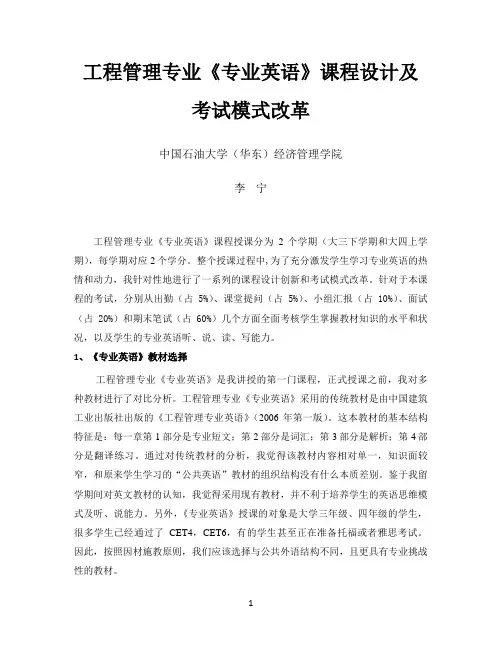
工程管理专业《专业英语》课程设计及考试模式改革中国石油大学(华东)经济管理学院李宁工程管理专业《专业英语》课程授课分为2个学期(大三下学期和大四上学期),每学期对应2个学分。
整个授课过程中,为了充分激发学生学习专业英语的热情和动力,我针对性地进行了一系列的课程设计创新和考试模式改革。
针对于本课程的考试,分别从出勤(占5%)、课堂提问(占5%)、小组汇报(占10%)、面试(占20%)和期末笔试(占60%)几个方面全面考核学生掌握教材知识的水平和状况,以及学生的专业英语听、说、读、写能力。
1、《专业英语》教材选择工程管理专业《专业英语》是我讲授的第一门课程,正式授课之前,我对多种教材进行了对比分析。
工程管理专业《专业英语》采用的传统教材是由中国建筑工业出版社出版的《工程管理专业英语》(2006年第一版)。
这本教材的基本结构特征是:每一章第1部分是专业短文;第2部分是词汇;第3部分是解析;第4部分是翻译练习。
通过对传统教材的分析,我觉得该教材内容相对单一,知识面较窄,和原来学生学习的“公共英语”教材的组织结构没有什么本质差别。
鉴于我留学期间对英文教材的认知,我觉得采用现有教材,并不利于培养学生的英语思维模式及听、说能力。
另外,《专业英语》授课的对象是大学三年级、四年级的学生,很多学生已经通过了CET4,CET6,有的学生甚至正在准备托福或者雅思考试。
因此,按照因材施教原则,我们应该选择与公共外语结构不同,且更具有专业挑战性的教材。
通过网络信息搜索和其他国内外高校对工程管理教材的评价,我最终选择了英文原版教材的影印版《管理工程与技术Managing Engineering and Technology》。
该教材由美国学者Lucy C. Morse 和Daniel L. Babcock主编,并且被美国多所大学管理工程专业广泛采用。
由于这本教材中既包含工程管理的重要理论,又涵盖许多量化分析模型与方法,非常适合工程管理学生的专业知识学习。
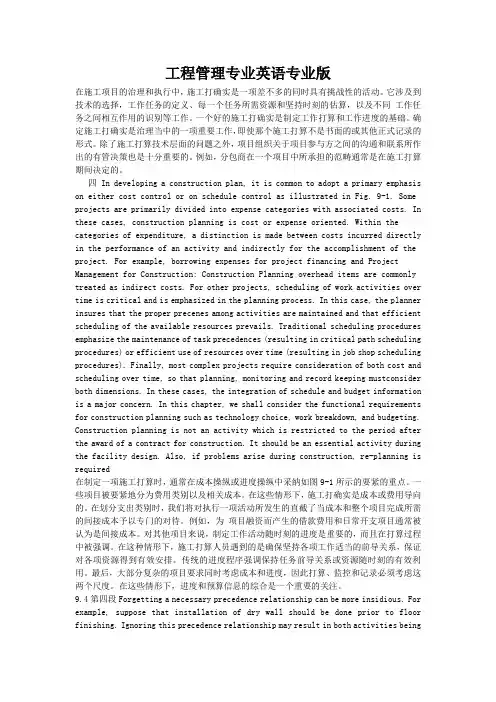
工程管理专业英语专业版在施工项目的治理和执行中,施工打确实是一项差不多的同时具有挑战性的活动。
它涉及到技术的选择,工作任务的定义、每一个任务所需资源和坚持时刻的估算,以及不同工作任务之间相互作用的识别等工作。
一个好的施工打确实是制定工作打算和工作进度的基础。
确定施工打确实是治理当中的一项重要工作,即使那个施工打算不是书面的或其他正式记录的形式。
除了施工打算技术层面的问题之外,项目组织关于项目参与方之间的沟通和联系所作出的有管决策也是十分重要的。
例如,分包商在一个项目中所承担的范畴通常是在施工打算期间决定的。
四 In developing a construction plan, it is common to adopt a primary emphasis on either cost control or on schedule control as illustrated in Fig. 9-1. Some projects are primarily divided into expense categories with associated costs. In these cases, construction planning is cost or expense oriented. Within the categories of expenditure, a distinction is made between costs incurred directly in the performance of an activity and indirectly for the accomplishment of the project. For example, borrowing expenses for project financing and Project Management for Construction: Construction Planning overhead items are commonly treated as indirect costs. For other projects, scheduling of work activities over time is critical and is emphasized in the planning process. In this case, the planner insures that the proper precenes among activities are maintained and that efficient scheduling of the available resources prevails. Traditional scheduling procedures emphasize the maintenance of task precedences (resulting in critical path scheduling procedures) or efficient use of resources over time (resulting in job shop scheduling procedures). Finally, most complex projects require consideration of both cost and scheduling over time, so that planning, monitoring and record keeping mustconsider both dimensions. In these cases, the integration of schedule and budget information is a major concern. In this chapter, we shall consider the functional requirements for construction planning such as technology choice, work breakdown, and budgeting. Construction planning is not an activity which is restricted to the period after the award of a contract for construction. It should be an essential activity during the facility design. Also, if problems arise during construction, re-planning is required在制定一项施工打算时,通常在成本操纵或进度操纵中采纳如图9-1所示的要紧的重点。
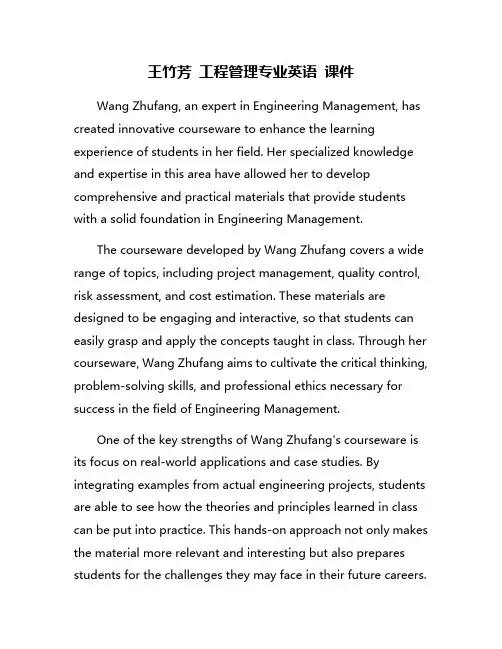
王竹芳工程管理专业英语课件Wang Zhufang, an expert in Engineering Management, has created innovative courseware to enhance the learning experience of students in her field. Her specialized knowledge and expertise in this area have allowed her to develop comprehensive and practical materials that provide students with a solid foundation in Engineering Management.The courseware developed by Wang Zhufang covers a wide range of topics, including project management, quality control, risk assessment, and cost estimation. These materials are designed to be engaging and interactive, so that students can easily grasp and apply the concepts taught in class. Through her courseware, Wang Zhufang aims to cultivate the critical thinking, problem-solving skills, and professional ethics necessary for success in the field of Engineering Management.One of the key strengths of Wang Zhufang's courseware is its focus on real-world applications and case studies. By integrating examples from actual engineering projects, students are able to see how the theories and principles learned in class can be put into practice. This hands-on approach not only makes the material more relevant and interesting but also prepares students for the challenges they may face in their future careers.In addition to her courseware, Wang Zhufang also incorporates the latest technologies and teaching methods into her classroom instruction. By using multimedia presentations, online simulations, and interactive exercises, she is able to cater to different learning styles and engage students more effectively. This blend of traditional teaching methods with modern tools and techniques ensures that students receive a well-rounded education that prepares them for the demands of the modern engineering industry.Overall, Wang Zhufang's courseware has been praised for its clarity, depth, and practicality. By providing students with a solid understanding of Engineering Management principles and practices, she is helping to shape the next generation of engineers and managers who will lead the way in the field. Her dedication to excellence and innovation in education is truly commendable, and her contributions to the field of Engineering Management are invaluable.。
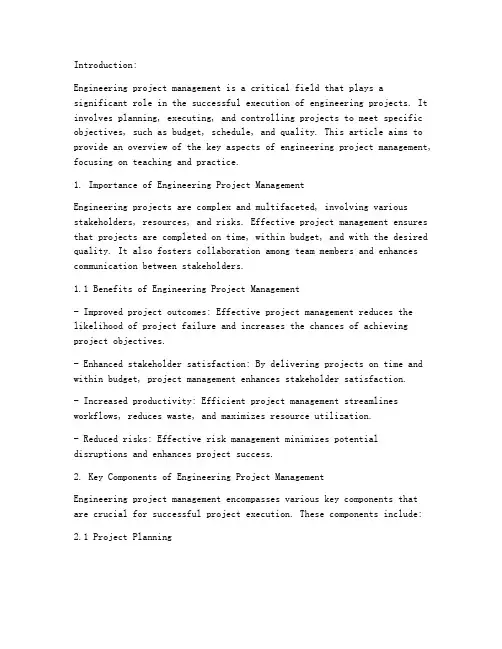
Introduction:Engineering project management is a critical field that plays a significant role in the successful execution of engineering projects. It involves planning, executing, and controlling projects to meet specific objectives, such as budget, schedule, and quality. This article aims to provide an overview of the key aspects of engineering project management, focusing on teaching and practice.1. Importance of Engineering Project ManagementEngineering projects are complex and multifaceted, involving various stakeholders, resources, and risks. Effective project management ensures that projects are completed on time, within budget, and with the desired quality. It also fosters collaboration among team members and enhances communication between stakeholders.1.1 Benefits of Engineering Project Management- Improved project outcomes: Effective project management reduces the likelihood of project failure and increases the chances of achieving project objectives.- Enhanced stakeholder satisfaction: By delivering projects on time and within budget, project management enhances stakeholder satisfaction.- Increased productivity: Efficient project management streamlines workflows, reduces waste, and maximizes resource utilization.- Reduced risks: Effective risk management minimizes potentialdisruptions and enhances project success.2. Key Components of Engineering Project ManagementEngineering project management encompasses various key components that are crucial for successful project execution. These components include:2.1 Project PlanningProject planning is the process of defining project objectives, scope, schedule, and resources required to achieve those objectives. It involves:- Defining project objectives: Identifying the goals and desired outcomes of the project.- Establishing project scope: Defining the boundaries and deliverablesof the project.- Developing a project schedule: Creating a timeline for projectactivities and milestones.- Identifying project resources: Determining the human, financial, and material resources needed for project execution.2.2 Project ExecutionProject execution involves the actual implementation of the project plan. It includes:- Coordinating project activities: Assigning tasks to team members and ensuring they are completed on time.- Managing resources: Ensuring that the required resources are available and effectively utilized.- Monitoring project progress: Tracking the progress of projectactivities and comparing them against the planned schedule.- Controlling project scope: Managing changes to the project scope to ensure that the project objectives are met.2.3 Project ControlProject control is the process of monitoring and managing project performance to ensure that it aligns with the planned objectives. It includes:- Performance measurement: Assessing the progress of project activities against the planned schedule and budget.- Change management: Managing changes to the project scope, schedule, and resources.- Risk management: Identifying, analyzing, and mitigating potentialrisks to the project.- Quality management: Ensuring that the project deliverables meet the required quality standards.3. Teaching Engineering Project ManagementTeaching engineering project management requires a comprehensive curriculum that covers both theoretical and practical aspects. The following are some key elements of teaching engineering project management:3.1 Course ContentEngineering project management courses should cover the following topics:- Project management principles and methodologies- Project planning and scheduling- Risk and quality management- Communication and teamwork- Project finance and procurement- Project stakeholders and management3.2 Teaching MethodsEffective teaching methods should be employed to facilitate learning and practical application of project management concepts. These methods include:- Lectures: Providing foundational knowledge on project management principles.- Case studies: Analyzing real-world project scenarios to enhance understanding.- Group projects: Encouraging teamwork and practical application of project management skills.- Workshops: Offering hands-on experience in project planning and execution.- Guest lectures: Inviting industry experts to share their experiences and insights.4. Practice of Engineering Project ManagementThe practice of engineering project management involves applying the theoretical knowledge and skills learned in the classroom to real-world projects. Some key aspects of practicing engineering project management include:4.1 Project Selection and EvaluationSelecting the right project is crucial for success. This involves evaluating potential projects based on factors such as feasibility, alignment with organizational goals, and available resources.4.2 Project Planning and ExecutionDeveloping a comprehensive project plan and executing it effectively is essential. This includes coordinating resources, managing risks, and ensuring quality throughout the project lifecycle.4.3 Communication and Stakeholder ManagementEffective communication and stakeholder management are critical for project success. This involves maintaining open lines of communication, addressing stakeholder concerns, and ensuring that all parties are aligned with project objectives.4.4 Continuous ImprovementPracticing engineering project management requires a commitment to continuous improvement. This involves analyzing project outcomes, identifying areas for improvement, and implementing changes to enhance future project performance.Conclusion:Engineering project management is a vital field that plays a crucial role in the successful execution of engineering projects. Teaching and practicing engineering project management require a comprehensive understanding of key components, teaching methods, and practical application. By incorporating these elements, individuals can develop the necessary skills and knowledge to manage engineering projects effectively and contribute to the success of their organizations.。
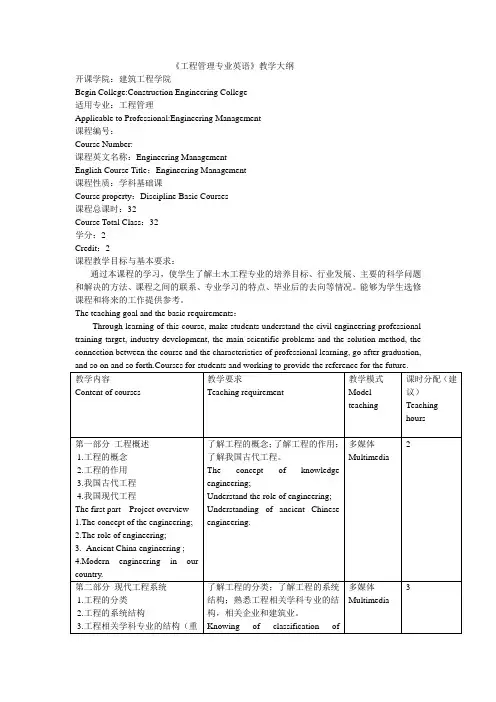
《工程管理专业英语》教学大纲开课学院:建筑工程学院Begin College:Construction Engineering College适用专业:工程管理Applicable to Professional:Engineering Management课程编号:Course Number:课程英文名称:Engineering ManagementEnglish Course Title:Engineering Management课程性质:学科基础课Course property:Discipline Basic Courses课程总课时:32Course Total Class:32学分:2Credit:2课程教学目标与基本要求:通过本课程的学习,使学生了解土木工程专业的培养目标、行业发展、主要的科学问题和解决的方法、课程之间的联系、专业学习的特点、毕业后的去向等情况。
能够为学生选修课程和将来的工作提供参考。
The teaching goal and the basic requirements:Through learning of this course, make students understand the civil engineering professional training target, industry development, the main scientific problems and the solution method, the connection between the course and the characteristics of professional learning, go after graduation, and so on and so forth.Courses for students and working to provide the reference for the future.教学内容Content of courses 教学要求Teaching requirement教学模式Modelteaching课时分配(建议)Teachinghours第一部分工程概述1.工程的概念2.工程的作用3.我国古代工程4.我国现代工程The first part Project overview1.The concept of the engineering;2.The role of engineering;3. Ancient China engineering ;4.Modern engineering in our country. 了解工程的概念;了解工程的作用;了解我国古代工程。
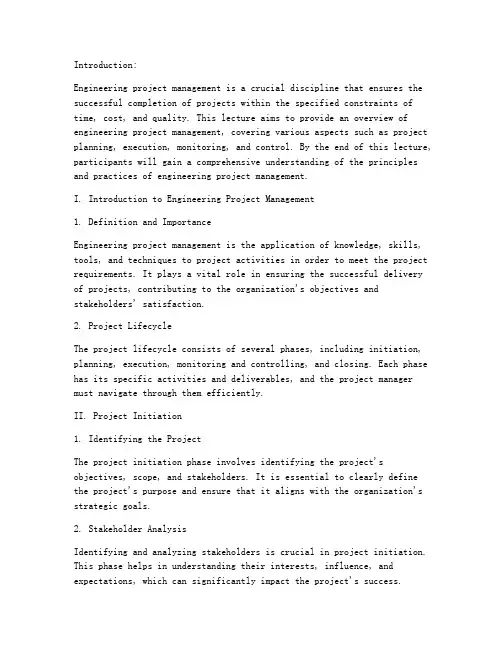
Introduction:Engineering project management is a crucial discipline that ensures the successful completion of projects within the specified constraints of time, cost, and quality. This lecture aims to provide an overview of engineering project management, covering various aspects such as project planning, execution, monitoring, and control. By the end of this lecture, participants will gain a comprehensive understanding of the principles and practices of engineering project management.I. Introduction to Engineering Project Management1. Definition and ImportanceEngineering project management is the application of knowledge, skills, tools, and techniques to project activities in order to meet the project requirements. It plays a vital role in ensuring the successful delivery of projects, contributing to the organization's objectives and stakeholders' satisfaction.2. Project LifecycleThe project lifecycle consists of several phases, including initiation, planning, execution, monitoring and controlling, and closing. Each phase has its specific activities and deliverables, and the project manager must navigate through them efficiently.II. Project Initiation1. Identifying the ProjectThe project initiation phase involves identifying the project's objectives, scope, and stakeholders. It is essential to clearly define the project's purpose and ensure that it aligns with the organization's strategic goals.2. Stakeholder AnalysisIdentifying and analyzing stakeholders is crucial in project initiation. This phase helps in understanding their interests, influence, and expectations, which can significantly impact the project's success.III. Project Planning1. Scope DefinitionScope definition is a critical activity in project planning. It involves determining the project's boundaries, deliverables, and constraints. This step helps in setting clear expectations and managing scope creep.2. Work Breakdown Structure (WBS)The Work Breakdown Structure (WBS) is a hierarchical decomposition of the project scope into smaller, manageable components. It helps in organizing and planning the project activities, assigning responsibilities, and estimating resources.3. Schedule DevelopmentThe project schedule outlines the sequence of activities and their durations. Techniques like Critical Path Method (CPM) and Program Evaluation and Review Technique (PERT) can be used to develop an accurate schedule.4. Resource AllocationResource allocation involves identifying the resources required for each activity, including personnel, equipment, and materials. This step helps in managing resources efficiently and ensuring their availability when needed.5. Budget EstimationBudget estimation involves determining the project's financial requirements, including costs for labor, materials, equipment, and other expenses. Accurate budgeting helps in controlling costs and avoiding financial constraints.IV. Project Execution1. Team LeadershipEffective leadership is essential in project execution. The project manager must motivate and guide the team, ensure clear communication, and resolve conflicts to maintain project progress.2. Risk ManagementRisk management involves identifying, analyzing, and mitigating potential risks that may impact the project. Techniques like risk identification, risk analysis, and risk response planning help in minimizing the impact of risks on the project.3. Quality ManagementQuality management ensures that the project deliverables meet the specified requirements and standards. It involves activities like quality planning, quality assurance, and quality control.V. Project Monitoring and Control1. Performance MeasurementPerformance measurement involves monitoring the project's progress against the planned schedule, budget, and quality standards. Techniques like earned value management (EVM) can be used to assess the project's performance.2. Change ManagementChange management deals with managing changes that occur during the project lifecycle. This includes evaluating change requests, assessing their impact on the project, and implementing approved changes.3. Issue ManagementIssues can arise during the project, and it is crucial to address them promptly. Issue management involves identifying, analyzing, and resolving issues that may hinder the project's progress.VI. Project Closing1. Deliverable HandoverThe project closing phase involves delivering the final products or services to the stakeholders. It is essential to ensure that the deliverables meet the agreed-upon requirements and standards.2. Project EvaluationProject evaluation is a critical step in project closing. It involves assessing the project's performance against the initial objectives and identifying lessons learned for future projects.Conclusion:Engineering project management is a complex and dynamic field that requires a comprehensive understanding of various principles and practices. This lecture has provided an overview of the key aspects of engineering project management, from initiation to closing. By applying these concepts, project managers can ensure the successful delivery of projects within the specified constraints. Continuous learning and improvement in project management skills are essential for the growth and success of professionals in this field.。
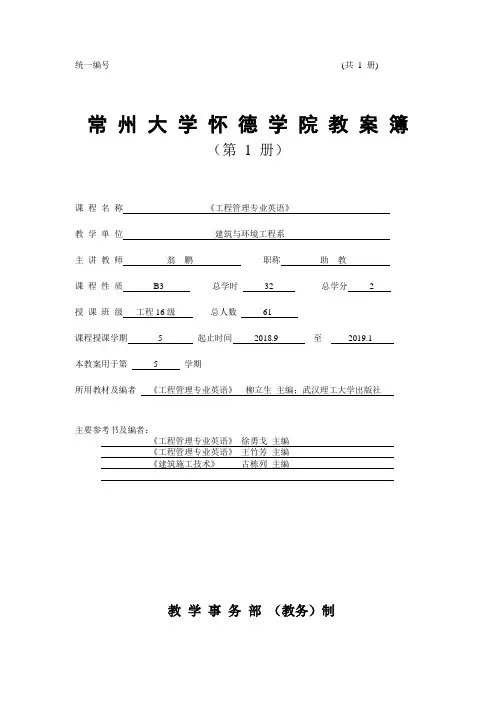
统一编号_____________ (共1 册)
常州大学怀德学院教案簿
(第 1 册)
课程名称《工程管理专业英语》
教学单位建筑与环境工程系
主讲教师翁鹏职称助教
课程性质B3 总学时32 总学分 2
授课班级工程16级总人数61
课程授课学期 5 起止时间2018.9 至2019.1
本教案用于第 5 学期
所用教材及编者《工程管理专业英语》柳立生主编;武汉理工大学出版社
主要参考书及编者:
《工程管理专业英语》徐勇戈主编
《工程管理专业英语》王竹芳主编
《建筑施工技术》古栋列主编
教学事务部(教务)制
本册教案目录
常州大学怀德学院教案
学生反馈。
